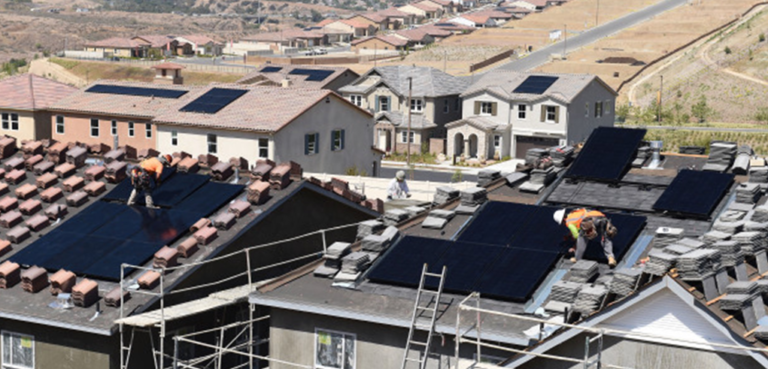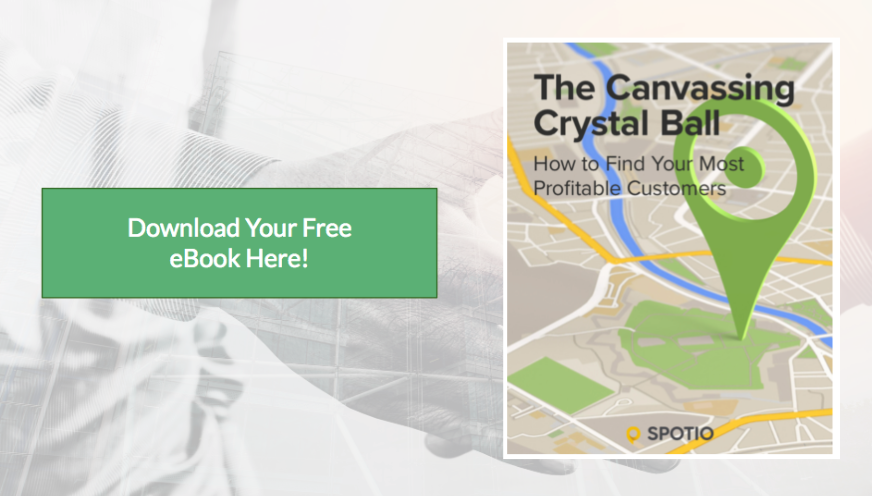The state of California is set to experience a massive shake up in just a couple short years. In May of this year, the California Energy Commission (CEC) passed a mandate to the state’s 2019 Building Energy Efficiency Standards that’s been two years in the making. While it came as a huge shock to many, maybe it really shouldn’t have.
Regardless of where you land on the ‘surprise scale,’ starting on January 1, 2020, all new homes will be required to have a solar roof installed.
The solar mandate applies to all new homes being built that will be under three stories tall. The jaw-dropping requirement is a first for the U.S., and one that aims to progress the development and advancement of clean energy. It’s believed that these standards will help to incentivize energy storage as well as include a host of energy efficiency upgrades.
The hope is that these upgrades will decrease energy use in new houses by more than 50% as a whole.
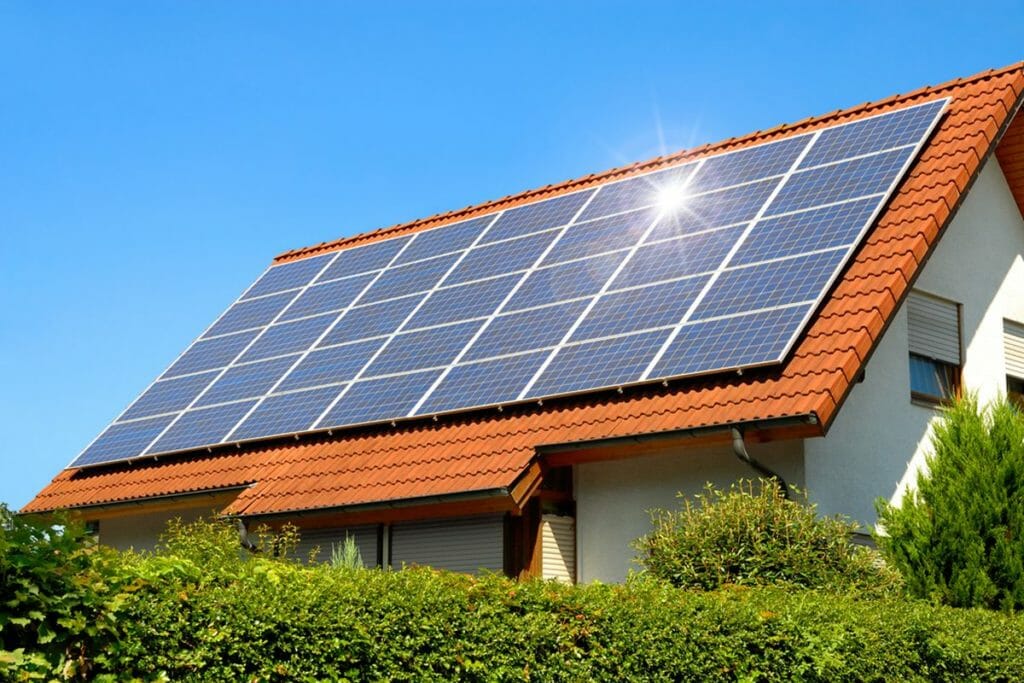
Getting these standards approved was the first step in the process but the real work is just beginning, especially for solar companies, homebuilders, efficiency experts, consumers, and more. These groups are seeking to understand the ins and outs of the new compliance standards and how they’ll actually affect the clean energy industry in its entirety.
What You Need to Know
It’s important to start familiarizing yourself and your company with the specifics of California’s solar mandate because there’s a million and one things to understand and digest. The new standards will be climate zone-specific and based on the floor area of the unit. The PV system is required to be sized to net out the yearly kilowatt-hour energy usage of the dwelling unit. This excludes common areas in multi-family homes as they’re not subject to regulation under the new initiative.
It’s anticipated that the size of the solar system will range from 2.7 kW to 5.7 kW depending on the location because of the parameters in place and new homes being more efficient in general. As it stands today, the average size of an installation to an existing home in the state of California is 6.8 kilowatts. Keep in mind this is for a retrofit system.
The reduced size for these systems has a considerable role in determining the expected costs and grid impacts of the new codes. Additionally, demand-responsive technologies like battery storage and heat pump water heaters, among others, will improve comfort and energy savings encouraged by the new standards.
The standards put in place for 2019 were created under the assumption of a mixed-fuel home using some level of natural gas for one reason or another. This is an important standard to remember that can be used during your pitch at the door. Homeowners utilizing less gas through electric space and water heating, or increasing their energy usage because they purchased an electric vehicle, won’t be required to add additional solar panels in order to be compliant.
As an alternative, some homeowners may decide to build a larger PV system so that they can be 100% electric. These types of intricacies need to be understood so that you’re viewed as an industry expert who has the knowledge and ability to help homeowners make an educated decision.
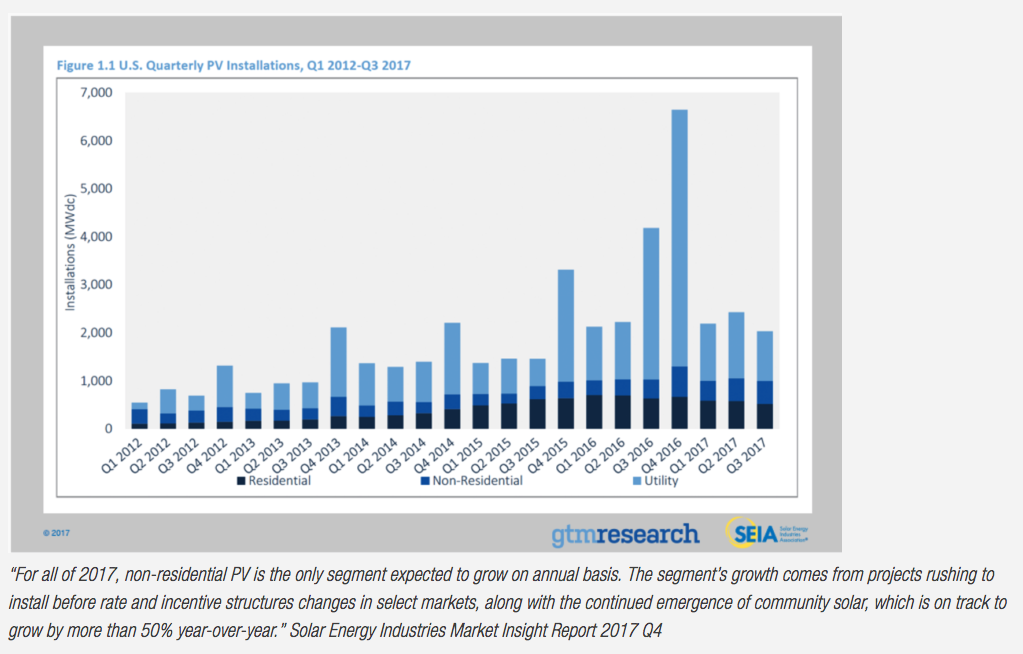
At the heart of the new initiatives, they’re essentially driven by the space and water heating, lighting, kitchen appliances, and equipment that people are most likely to bring into their home and plug into an electrical socket. Because of this, several flexibility measures have been implemented in the new mandates.
What’s critical to understand about the flexibility measures put in place is that local governments have the ability to make the rules tighter if they choose. For example, roughly ½ dozen Cali cities have already decided to make rooftop solar systems a requirement.
The state began this project way back in 2008 with the goal of establishing zero-net-energy use in all new houses by 2020. They created the same goal for commercial buildings to be completed by 2030. The CEC has been on par to make this happen as the previous three updates in 2010, 2014 and 2017 all aimed to move California as close as possible to net-zero-energy by 2020.
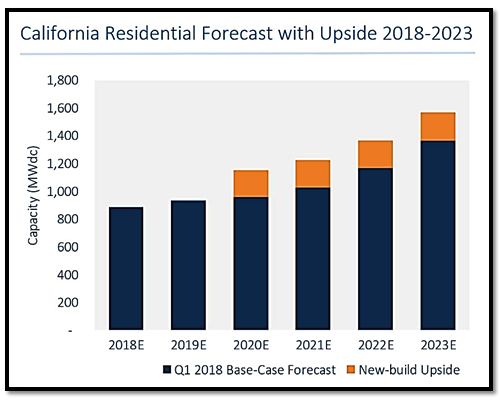
Canvassers & Sales Reps
In order to take full advantage of the Solar Gold Rush set to hit California in 2020, you need to establish your company’s sales process and have it running like a well-oiled machine in advance of the solar mandate. In other words, you need to start preparing for the changes that are set to hit the market now, as opposed to later.
With your prep work for the road ahead starting now, begin by looking at your sales team and determine whether you’re going to have a combination of canvassers and sales reps, or just full-cycle sales reps. Canvassers are essentially your foot soldiers – the ones who pound the pavement going door to door trying to gauge a homeowner’s interest level and set an appointment for the sales rep.
Some solar companies employ canvassers while others only use full-cycle sales reps. The advantage to using canvassers is that you set your salespeople up with homeowners that have genuine interest in purchasing solar. When a sales rep goes to an appointment they should have a much greater chance of closing the deal.
If you choose to forego canvassers and opt for sales reps only, they have to knock doors to set their own appointments in addition to trying to close the sale. Sales reps handling everything themselves from the beginning helps them to build more trust and rapport with the prospect. They’re also able to develop a better relationship with the homeowner, which should provide them with the ability to extract more information from the potential customer that they can use as leverage during the closing process.
Sales Tools
An extremely important component to preparing for the recently released solar mandates that shouldn’t be overlooked are the sales tools your organization should be using to achieve maximum efficiency. There’s a variety of technological tools that door to door and field sales companies should be using in today’s fast paced landscape.
Perhaps the most important tool you need to be effective is a field sales software like SPOTIO. A field sales software gives you the ability to log all of your sales activities, measure your team’s sales success with a dashboard that updates in real-time, and track each salesperson’s movement through live GPS locations and positioning to ensure they’re completing the activities they say they are.
There’s numerous other features that a field sales software provides to make your team more efficient than they’ve ever been, one of which is Lead Machine. This tool is exclusive to SPOTIO and gives solar companies the power to put their canvassers and sales reps in a position to speak with pre-qualified prospects that match your company’s ideal customer profile only.
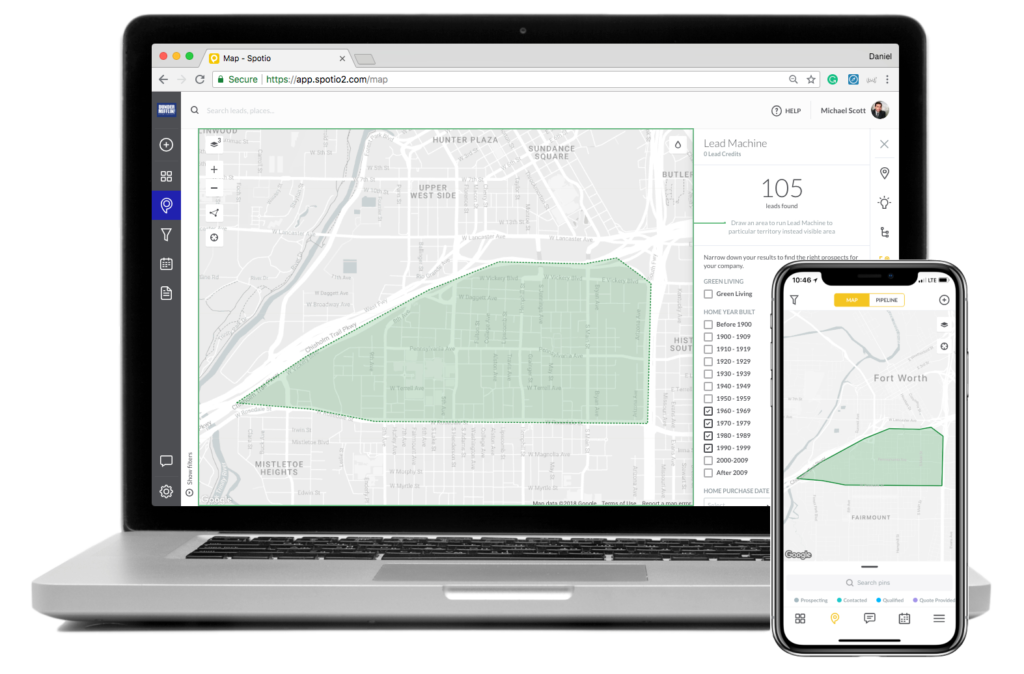
Using Lead Machine, you can filter unqualified prospects based on market demographics like home value, homeowner vs renter, credit capacity, date built and more. This prevents your salespeople from knocking every single door in a neighborhood or territory and places them directly on the doors of homeowners that match your requirements.
With the direction that content is headed, the last tool that is essential to door to door and field sales organizations is an email automation service like MailChimp. A platform like MailChimp makes it easier to complete tasks like lead nurturing. You’ll have the ability to get information to potential customers quicker and easier by automating these tasks.
The best part about all of these tools is that they integrate with one another through a third party service called Zapier. Creating the integrations and connecting the platforms to work together and share information couldn’t be easier with a service like this. Rather than wasting more of your sales reps’ time on simple administration tasks, automate them based on the triggers you set.
Tips & Tricks to Win More Business
With the amount of money to be made as a result of the new solar mandates, you can guarantee the level of competition is going to rise in the solar industry, and quickly. Don’t be late to the party.
#1 | Minimum # of Attempts
One of the largest mistakes door to door and field sales companies make is not requiring their canvassers and sales reps to track every attempt they make. This is your first tip to capturing your share of the cash grab. Implement your own mandate that enforces salespeople tracking their sales activities.
By tracking and measuring your attempts, the management team can determine how many attempts are required on a home in order to make a sale. Once this metric has been established, you’ll be able to ensure each neighborhood or territory has been worked to its maximum capacity. This will prevent your organization from leaving potential revenue on the table.
#2 | Lead Nurturing
Too many door to door and field sales businesses fail to use one of the most effective methods of communication available to them: email. Just because a customer says “no” doesn’t mean it is the end of their journey with your company.
In a February 2017 report by the Radicati Group, the number of email users worldwide is at a staggering 3.7 billion, with the number of daily emails being sent sitting at 269 billion. If you still think that email is biting the bullet, compare those numbers to the estimated 205 billion emails being sent daily in 2015, and 247 billion in 2009.
Further illustrating the strength of email, 86% of professionals stated that email is their favorite mode of communication. Where the tides have really turned is in the technology being used, as 66% of emails are read on mobile devices. This results in a 34.1% open rate in North America, and a 13.7% mobile / 18% desktop click-to-open rate for U.S. marketing emails.
Lead nurturing is the aspect of your sales process focused on developing relationships with buyers at every stage of your funnel, and through each step of the buyer’s journey. The process uses marketing and communication efforts that are geared toward listening and understanding the needs of prospects by offering valuable information and answers every step of the way.
The goal of nurturing is to further familiarize the prospect with your product through education. This process is not designed to convert prospects to customers now; it’s to build a relationship with non-sales ready individuals so that when they are ready, you’re their first and only call.
#3 | Maintain & Increase Engagement
To keep your company in the front of your prospect’s mind, maintain engagement with consumers who have already made contact with you. Sales reps often engage with consumers at inopportune moments, doing nothing but wasting everyone’s time.
Keeping up with engagement can be labor intensive if the process isn’t automated. Luckily there’s plenty of ways to save time and streamline the process, but it starts with giving your sales team the tools they need to succeed.
Before you can even get to engaging at the right time, you have to have an efficient process for canvassers and sales reps to collect homeowner information at the door. Just because a prospect isn’t interested at the current moment, doesn’t mean you should just “toss ‘em to the wind.”
Recognize the importance of a sales process in door to door sales, and how automating your engagement efforts in areas like social media and lead nurturing can remind prospects about your business once they’ve stopped visiting your site.
#4 | Push Referrals & New Lead Generation
Referrals are your highest converting & cheapest lead source, making them extremely valuable. Create a custom field in your sales tracking software titled “Referral,” and incentivize these types of sales. For some reason, one of the most difficult things for salespeople to do is ask for a referral, which is considerably surprising since 91% of customers state they would be willing to provide one but only 11% of salespeople ask.
Since referrals are the cheapest lead source and convert at a higher rate, it means you’re not having to spend as much money to get these types of customers. The result… you can incentivize these types of sales by offering more commission per opportunity. This is an excellent strategy to boost your sales numbers and shorten the length of your average sales cycle.
#5 | Eliminate Time Killers
Administrative tasks are the number one thing preventing salespeople from spending more time in the field, which is where they should be. Look for the admin work that can be automated through one tool or another. The minutes, and even seconds, you can save will begin to add up quickly, even if you don’t realize it initially.
Aside from just saving time, door to door and field salespeople will feel less flustered by the number of things weighing on them on a daily basis. This will allow sales reps to divert more of their energy and attention away from mundane tasks, and focus on things like running demos or answering questions that show buying potential.
Conclusion
There’s a massive opportunity getting ready to present itself to door to door and field sales companies in the solar industry. However, it’s one that requires you to start preparing now if you plan to capitalize on it. Your preparation begins with the sales processes inside your organization, like the structure of your sales team and the tools you use.
There’s numerous tips and tricks you can implement into your sales strategies to make the most of the opportunity. By making your team as efficient and effective as possible, and nurturing leads throughout the entire buying journey, you’ll keep your company’s name and reputation at the forefront of each prospect’s mind.
California’s solar mandate is a gold mine of new business. It’s imperative to get your plan in place now and start selling your solar services. Moreover, odds are that more and more states will implement something similar. So if you’re in the business of solar, it’s time to capitalize!
_____
Questions or comments? Contact SPOTIO at [email protected] or comment below.
SPOTIO is the #1 field sales automation and performance management software that will increase revenue, maximize profitability, and boost sales productivity.
Want to see a product demonstration? Click here to see how SPOTIO can take your sales game to the next level.

